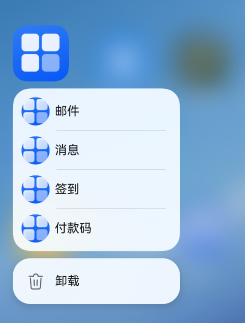HarmonyOS鸿蒙Next中桌面快捷方式怎么跳h5页面
HarmonyOS鸿蒙Next中桌面快捷方式怎么跳h5页面 h5页面是接口返回的地址,怎么通过长按应用拉起快捷方式,点击后直接跳入应用内的h5页面呢
应用静态快捷方式
随着应用的功能越来越复杂,用户在使用应用时,找到某个功能的操作步骤也变得更加繁琐。为提升用户体验,可以对应用中常用的功能创建对应的桌面快捷方式,以达到快速启动应用、一键直达特定功能等目的。例如相机应用的 “快速拍照”、便签应用的 “新建便签” 和地图应用的常用地点导航等功能的快捷方式,用户通过快捷方式可以快速进入特定功能页面,既能大大提高操作效率,同时也增加了用户对应用的依赖性。使用快捷方式,还可以实现个性化定制的需求,创建多个快捷方式,以满足个性化的工作流程和操作偏好。
场景介绍
以导航场景为例,用户使用地图应用导航时,通常先搜索目的地,然后开始导航。为了提升导航效率和操作便捷性,建议在地图应用中添加常去地点的快捷方式,如公司、家等。添加这些快捷方式后,用户长按应用图标,即可打开快捷方式入口,快速启动导航。详情请参考桌面快捷方式。
配置方法
下面介绍在工程中配置静态快捷方式的方法。
- 在entry/src/main/resources/base/element/string.json配置资源文件如下。
{
"string": [
// ···
{
"name": "share",
"value": "分享好友"
},
{
"name": "add",
"value": "添加收藏"
}
]
}
-
配置快捷方式文件。
在模块的/resources/base/profile/目录下配置快捷方式的配置文件,如shortcuts_config.json,拷贝示例代码需要删除注释。
{
"shortcuts": [
{
"shortcutId": "id_test1",
"label": "$string:add",
"icon": "$media:add_icon",
"wants": [
{
"bundleName": "com.ohos.hello",
"moduleName": "entry",
"abilityName": "EntryAbility1",
"parameters": {
"testKey": "testValue"
}
}
]
},
{
"shortcutId": "id_test2",
"label": "$string:share",
"icon": "$media:share_icon",
"wants": [
{
"bundleName": "com.ohos.hello",
"moduleName": "entry",
"abilityName": "EntryAbility",
"parameters": {
"testKey": "testValue"
}
}
]
}
]
}
- 在应用的module.json5文件中配置metadata,指向快捷方式的配置文件。
{
"module": {
// ...
"abilities": [
{
"name": "EntryAbility",
"srcEntry": "./ets/entryability/EntryAbility.ets",
// ...
"metadata": [
{
"name": "ohos.ability.shortcuts",
"resource": "$profile:shortcuts_config"
}
]
}
]
}
}
安装应用后,长按桌面上的应用图标,图标上方会显示开发者配置的快捷方式:“添加收藏"和"分享好友”。点击相应标签,可启动对应的组件。应用配置的静态快捷方式在桌面上的展示效果如下图所示。

更多关于HarmonyOS鸿蒙Next中桌面快捷方式怎么跳h5页面的实战系列教程也可以访问 https://www.itying.com/category-93-b0.html
【背景知识】
productViewManager:提供展示应用/元服务详情页、应用内快捷方式加桌的能力。
【参考方案】
可参考地铁线路图添加桌面示例,通过productViewManager提供应用内快捷方式添加至桌面的能力。
- 构造调用checkPinShortcutPermitted接口校验桌面快捷方式的参数。
let uiContext = this.getUIContext().getHostContext() as common.UIAbilityContext;
let shortcutId = 'id_map'; // 对应shortcuts标签中配置的shortcutId
let labelResName = 'go_to_map'; // 对应shortcuts标签中配置的label资源索引名称
let iconResName = 'metro'; // 对应shortcuts标签中配置的icon资源索引名称
let want: Want = { // 对应shortcuts标签中配置的want
bundleName: 'com.example.addshortcuttodesktop',
moduleName: 'entry',
abilityName: 'EntryAbility',
parameters: {
shortCutKey: 'MainPage'
}
}
- 调用checkPinShortcutPermitted接口,将步骤1中的参数依次传入接口中,并保存异步返回的结果CheckShortcutResult。调用requestNewPinShortcut接口,将异步结果的tid传入,执行添加到桌面的操作。
let checkShortcutResult: productViewManager.CheckShortcutResult;
productViewManager.checkPinShortcutPermitted(uiContext, shortcutId, want, labelResName, iconResName)
.then((result: productViewManager.CheckShortcutResult) => {
checkShortcutResult = result;
let tid = checkShortcutResult.tid;
productViewManager.requestNewPinShortcut(uiContext, tid)
})
- 在/resources/base/profile/目录下创建名为shortcuts_config.json的文件,并在文件中定义应用快捷方式的相关配置。
{
"shortcuts": [
{
"shortcutId": "id_map",
"label": "$string:go_to_map",
"icon": "$media:metro",
"wants": [
{
"bundleName": "com.example.addshortcuttodesktop",
"moduleName": "entry",
"abilityName": "EntryAbility",
"parameters": {
"shortCutKey": "MainPage"
}
}
]
}
]
}
- 在module.json5配置文件中的abilities标签下的metadata中设置resource属性值为$profile:shortcuts_config,指定应用的快捷方式配置文件,即使用shortcuts_config.json文件中的shortcuts配置。
"metadata": [
{
"name": "ohos.ability.shortcuts", // 配置快捷方式,该值固定为ohos.ability.shortcuts
"resource": "$profile:shortcuts_config" // 指定shortcuts信息的资源位置
}
]
你是要这种效果吗?

原理: 给 UIAbility 配置快捷方式,快捷方式中包含 Want,用户点击该快捷方式之后,系统通过 Want 中的信息拉起应用,在UIAbility中处理Want中携带的目标页面参数来决定进入到应用中的哪一个内页。以下是大概实现步骤:
- 打开
\entry\src\main\**module.json5**,给对应 UIAbility 新增快捷方式元数据:
{
"module": {
"name": "entry",
"type": "entry",
"srcEntry": "./ets/abilityStage/NotificationAbilityStage.ets",
"mainElement": "EntryAbility",
// ...这里省略一些其他属性
"abilities": [
{
"name": "EntryAbility",
"srcEntry": "./ets/entryability/EntryAbility.ets",
"metadata": [
// 关键:给需要配置快捷方式的UIAbility新增shortcuts属性
{
// name 必须为这个
"name": "ohos.ability.shortcuts",
// 对应资源文件名称可以自定义
"resource": "$profile:shortcuts_config"
}
]
},
}
}
\entry\src\main\resources\base\**profile**文件夹内新增文件**shortcuts_config.json**:
{
"shortcuts": [
{
"shortcutId": "shortcut_id_email",
"label": "$string:shortcut_label_email",
"icon": "$media:startIcon",
"wants": [
{
// 将下面几个属性值替换为你自己的应用信息
"bundleName": "com.xxx.xxx",
"moduleName": "entry",
"abilityName": "NotificationAbility",
"parameters": {
// 目标页面 该属性名可以自定义,属性值为你的 webview 组件页面名称
"targetPage": "NotificationPage1",
// ...其他额外参数
}
}
]
},
}
这里就是放了每个快捷方式对应的Want信息,以及额外参数:目标页面。
- 在UIAbility中写热启动路由跳转等业务代码。
由于跳转应用内页(页面路由)需要考虑当前应用是否已经打开。建议了解一下UIAbility组件启动模式,理解应用在已经打开**(热启动)和未打开时(冷启动)**UIAbility中回调方法执行顺序的区别。
UIAbility默认为singleton(单实例模式)。这里就以默认单实例启动模式,写一个简单示例代码并做简短说明:- 示例代码内为应用首页使用 Navigation (推荐) 路由页面,如果使用** router(已过时)**,请鼠标左键点击该链接参考其中的api自行实现。
- onCreate、**onNewWant **中判断是否进行页面路由的业务代码,可以依照你的业务需求来进行判断。
- 这段代码主要关注使用
**want.parameters?.targetPage**方法来获取 shortcuts_config.json 中 Want 携带的目标页面参数。
import { window } from '@kit.ArkUI'
import { AbilityConstant, UIAbility, Want, WantAgent, wantAgent } from '@kit.AbilityKit'
import { notificationManager } from '@kit.NotificationKit';
import { BusinessError } from '@kit.BasicServicesKit';
import { hilog } from '@kit.PerformanceAnalysisKit';
import { JSON } from '@kit.ArkTS';
export default class NotificationAbility extends UIAbility {
// want目标页面
private targetPage: string = '';
// 冷启动入口(由于此时应用首页还未渲染出来,故冷启动时在应用首页判断)
onCreate(want: Want, launchParam: AbilityConstant.LaunchParam): void {
hilog.info(DOMAIN_NUMBER, TAG, `#onCreate: want.parameters is ${JSON.stringify(want.parameters)}`)
this.targetPage = want.parameters?.targetPage as string || ''
AppStorage.setOrCreate<string>('targetPage', this.targetPage);
}
// 热启动入口(直接判断是否路由页面)
onNewWant(want: Want, launchParam: AbilityConstant.LaunchParam) {
hilog.info(DOMAIN_NUMBER, TAG, `#onNewWant: want.parameters is ${JSON.stringify(want.parameters)}`)
this.targetPage = want.parameters?.targetPage as string || '';
if (this.targetPage.trim().length !== 0) {
// 获取当前路由页面
let currentPage: string = AppStorage.get<string>('currentPage') || '';
// 获取首页Navigation页面栈
let pageInfos: NavPathStack | undefined = AppStorage.get<NavPathStack>('pageInfos');
if (undefined == pageInfos) {
return;
}
// 判断是否需要路由
if (this.targetPage.trim().length !== 0 && currentPage !== this.targetPage && this.targetPage !== 'NotificationIndex') {
currentPage = this.targetPage
// router.clear()
hilog.info(DOMAIN_NUMBER, TAG, `#routerByNewWant#pushPathByName(${this.targetPage})`)
pageInfos.pushPathByName(this.targetPage, null)
}
// 目标页面消费之后置空
AppStorage.setOrCreate<string>('targetPage', '');
// 更新当前路由页面
AppStorage.setOrCreate<string>('currentPage', this.targetPage);
}
}
onWindowStageCreate(windowStage: window.WindowStage): Promise<void> {
hilog.info(DOMAIN_NUMBER, TAG, `#onWindowStageCreate()`)
// 默认加载的页面路径
let pageUrl = 'NotificationIndex';
// 记录当前页面url
AppStorage.setOrCreate<string>('currentPage', pageUrl);
windowStage.loadContent(`pages/${pageUrl}`)
.then(() => {
hilog.info(DOMAIN_NUMBER, TAG, `#onWindowStageCreate#windowStage.loadContent(${pageUrl}): Successfully!`)
})
.catch((error: BusinessError) => {
hilog.error(DOMAIN_NUMBER, TAG,
`ERROR: #onWindowStageCreate#windowStage.loadContent(${pageUrl}), Cause: ${JSON.stringify(error)}`);
});
}
}
- 应用首页处理冷启动时的页面路由:
// NotificationIndex 应用首页
import { hilog } from '@kit.PerformanceAnalysisKit';
import { BusinessError } from '@kit.BasicServicesKit';
import { JSON } from '@kit.ArkTS';
const DOMAIN_NUMBER: number = 0xAAAA;
const TAG: string = 'NotificationIndex'
// Navigation路由表Builder
@Builder
export function NotificationIndexBuilder(name: string, param: Object) {
NotificationIndex()
}
@Entry
@Component
struct NotificationIndex {
pageInfos: NavPathStack = new NavPathStack();
build() {
Navigation(this.pageInfos){
Column() {
Text('应用首页')
}
}
.title('NotificationIndex')
}
aboutToAppear(): void {
hilog.info(DOMAIN_NUMBER, TAG, `#aboutToAppear()`)
// 存储Navigation页面栈,在应用热启动时候使用
AppStorage.setOrCreate('pageInfos', this.pageInfos)
}
onDidBuild(): void {
hilog.info(DOMAIN_NUMBER, TAG, `#onDidBuild()`)
this.routerByWant()
}
/**
* 通过Want中的信息进行页面路由
*/
private routerByWant() {
hilog.info(DOMAIN_NUMBER, TAG, `#routerByWant()`)
// 获取want中的目标页面
let targetPage: string = AppStorage.get<string>('targetPage') || '';
// 获取当前路由页面
let currentPage: string = AppStorage.get<string>('currentPage') || ''
// 判断是否需要路由
if (targetPage.trim().length !== 0 && currentPage !== targetPage && targetPage !== 'NotificationIndex') {
currentPage = targetPage
hilog.info(DOMAIN_NUMBER, TAG, `#routerByNewWant#pushPathByName(${targetPage})`)
this.pageInfos.pushPathByName(targetPage, null)
}
// 目标页面消费之后置空
AppStorage.setOrCreate<string>('targetPage', '');
// 更新当前路由页面
AppStorage.setOrCreate<string>('currentPage', targetPage);
}
}
在HarmonyOS Next中,通过UIAbility的Want配置实现桌面快捷方式跳转H5页面。首先在module.json5配置文件中声明UIAbility,设置actions为"ohos.want.action.view"和entities为[“entity.system.h5”]。在配置文件中为UIAbility添加"skills"字段,指定"entities"和"actions"匹配H5页面。使用Web组件加载目标URL,通过startAbility方法触发跳转。整个过程基于ArkTS开发,无需依赖Java或C语言。
在HarmonyOS Next中,可以通过以下步骤实现从桌面快捷方式跳转到应用内的H5页面:
-
配置Ability信息:在module.json5文件中,为目标H5页面配置一个Ability,类型设为"page",并设置正确的url参数指向H5地址。
-
添加快捷方式:在应用的Shortcuts配置中定义快捷方式,关联到上述Ability。在resources/base/profile/shortcuts_config.json中配置:
{
"shortcuts": [
{
"shortcutId": "h5_shortcut",
"label": "跳转H5",
"icon": "$media:icon",
"intents": [
{
"targetBundle": "你的应用包名",
"targetModule": "模块名",
"targetAbility": "配置的Ability名称"
}
]
}
]
}
-
动态处理URL:如果H5地址是接口动态返回的,可在Ability的onCreate生命周期中通过参数传递URL,或通过全局变量管理。
-
权限声明:确保在module.json5中声明ohos.permission.SET_ABILITY_CONTROLLER权限。
完成配置后,用户长按应用图标即可看到快捷方式,点击后会直接启动应用并跳转到指定的H5页面。注意确保H5地址的有效性和网络可用性。






